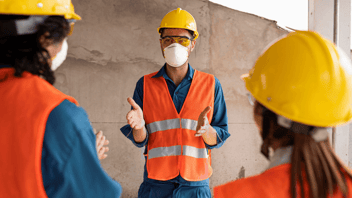What To Know as a Steel Manufacturer
Ensuring employee safety is the responsibility of employers in steel manufacturing plants. It is essential to make workers feel secure while working in hazardous conditions and focus on plant operations rather than safety concerns. However, steel factory workers experience challenging conditions daily, including exposure to blast and electric furnaces, dangerous machinery and equipment, and hazardous chemicals like ammonia and other gases.
While it is impractical to eliminate all hazards associated with steel manufacturers entirely, it is practical to minimize them. Employers, supervisors, and workers can prioritize safety, benefiting all parties involved.
6 Steel Manufacturer Safety Necessities
Providing Personal Protective Equipment (PPE) to employees is crucial for their safety in the workplace and is a legal requirement for companies. Here are the top six personal protective equipment required in steel manufacturing industries.
Head and Torso Protection
Protective hats protect steelworkers from impact blows and electrical hazards. These helmets must be capable of absorbing shock and preventing penetration. Head protection is necessary when performing tasks that might result in falling objects or contact with electrical hazards. Every helmet has a specific class and type corresponding to the hazardous conditions it protects against.
Torso protection that comprises safety suits and vests must be worn during tasks that might cause bodily harm from extreme temperatures, toxic chemicals, radiation, flames, and sparks.
Arm and Hand Protection
In steel manufacturing companies, arm and hand injuries are the most prevalent. Although protection cannot eliminate the risk of injury, it can be used to minimize it. Workers should put on a variety of gloves, hand pads, wristlets, and sleeves if they are working on tasks that have the potential to cause hand and skin burns, fractures, cuts, amputations, or absorption of harmful substances.
Eye and Face Protection
Employees in steel plants must wear appropriate eye and face protectors since there is a risk of injury to the eyes or face from molten metal, flying particles, chemical gases or vapors, and liquid chemicals. These safety gear can include face shields, safety goggles, and other protectors. These protectors must always be worn when performing tasks that might lead to vision loss, eye injury, burns, or exposure to toxic liquids.
Respiratory Protection
Respiratory protection is vital in steel manufacturing companies, as many tasks involve harmful particle inhalation. Before putting on a respirator, workers must undergo a thorough medical clearance and fit-testing, and this should happen at least yearly and before initial use. Employees must perform a positive and negative pressure seal check before using a tight-fitting respirator.
Ear Protection
Noise is a common occupational health issue that can cause permanent hearing loss, irritability, sleeplessness, and other harmful health effects. Ear protection aims to reduce or prevent the progression of noise-induced hearing loss, whether permanent or temporary. Whenever changes happen in production, process, or even controls that increase noise exposure, assessment must be repeated, and the gadgets used to monitor workers' exposures should be thoroughly monitored or calibrated to ascertain precise measurements.
Foot and Leg Protection
Protective gear such as safety boots and knee pads are crucial when working in steel plants, as there are risks of serious foot and leg injuries. The prevalent foot injury is caused by objects weighing around 65 pounds falling from a distance of fewer than four feet. Employees should always put foot and leg protection where there is a risk of rolling or falling objects, exposure to cold or hot materials, objects that may pierce the sole, hazardous liquids, contact with electric current, or slippery surfaces.
What Else You Need at a Steel Manufacturer Plant
Over time, employees and managers may become careless or complacent about safety, especially if there haven't been any accidents. They might skip using personal protective equipment for a quick task or ignore missing or broken safety gates. However, accidents can happen at any time, so regular workplace audits are necessary to maintain a culture of safety.
Keeping up-to-date with the latest safety practices and equipment is vital. New employees should receive training on equipment and facility safety procedures while existing employees should have periodic refresher courses. Training should cover the "how" and the "why" behind safety protocols. By understanding the potential injuries that can occur in a steel plant, employees are more likely to comply with safety protocols.
What To Avoid When Working in a Steel Plant
In summary, working in a steel plant requires workers always to be alert and safety-conscious. Workers can reduce the risk of accidents and injuries by avoiding loose clothing, inappropriate footwear, inattentiveness, improper use of machinery, and handling hazardous chemicals without protective gear. Safety should always be a top priority when working in a steel plant.
Written by Taylor McKnight, Author for Simple Weld






Leave a Comment